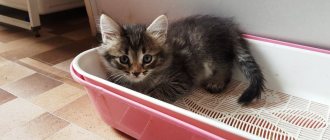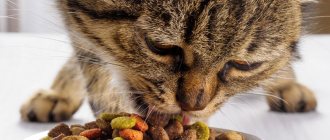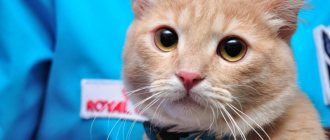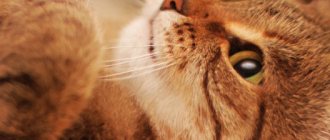A fairly common pathology in domestic cats, characterized by one or both testes not descending into the scrotum, is called cryptorchidism. A cryptorchid cat is not considered sick to the fullest extent of the word, but the phenomenon negatively affects the animal’s ability to produce offspring, and can also cause other ailments.
Today we will talk about how to identify cryptorchidism in a cat, whether castration of cryptorchid cats is mandatory, how the pathology is operated on, and we will discuss post-operative care for the animal.
Cryptorchid cat: surgery
Types of anomaly
The deviation in the form of cryptorchidism in cats is classified into several types, determined by the dislocation of the testicles. Each of them exhibits special symptoms that distinguish it from others, namely:
- Abdominal cryptorchidism . Characterized by the location of the testicle in the abdominal cavity. Often it is underdeveloped and hidden in the fatty layer of the peritoneum. Such an anomaly can only be determined using ultrasound; palpation or visual inspection cannot do this.
- Inguinal. A cat's testicle is located in the inguinal canal. It can be seen with a simple glance and determined by palpation.
- Pseudocryptorchidism or false type . In this case, the testicle moves freely from the groin to the abdominal cavity and back. This movement is caused by stress or hypothermia.
- Secondary. This type is a subtype of false, manifested by free movement along the peritoneum and along the length of the inguinal canal, ignoring the scrotum. It is believed that this condition is caused by underdevelopment of the seminal canals.
If cryptorchidism is suspected in a cat, the owners of such an animal need to know that in veterinary medicine, if there is a violation of the location of the testes in the cat in the right place for them, it is usually designated as dystopia. Moreover, in the case of the inguinal type of anomaly, subcutaneous dystopia usually occurs, and in the case of the abdominal type, internal dystopia occurs.
Is cryptorchidism a disease in cats?
The reason for castration of a cryptorchid cat is not obvious to every owner. In order to understand this issue, it is enough to clarify the essence of this concept and determine the level of its danger.
What is cryptorchidism
Cryptorchidism in cats is a congenital anomaly that does not pose a threat to others. It manifests itself in the incorrect location of the testes (testicles) and excludes other physiological disorders. As a result of this anomaly, one or both organs do not descend into the scrotum, but remain in the inguinal canal or abdominal cavity.
Similar pathologies include monorchism and anorchism, which involve the congenital absence of one or both testes. If a cat has only one testicle, then his body has a low level of testosterone. This feature excludes interest in the opposite sex, so pets with this anomaly cannot participate in breeding.
The attraction to females in cryptorchid cats remains, and the need for castration is explained by the low quality of sperm. It is almost impossible to obtain offspring from such animals. Fortunately for breeders, the probability of giving birth to cryptorchids is no more than 3%.
What is the danger
The main purpose of the scrotum is to preserve the viability of sperm due to the lower temperature. The testes remaining in the peritoneum or inguinal canal are constantly overheated, which leads to the following complications:
- Loss of reproductive function
. If both testicles have not descended in a cat, he is diagnosed with infertility. With a unilateral form of pathology, only the quality of sperm suffers. Fertilization sometimes occurs, but is achieved with great difficulty.
- Hormonal disorders
. Due to the loss of testosterone, the pet develops feminization syndrome. The cat begins to attract other males, and its mammary glands enlarge. Another sign of this disorder is asymmetrical alopecia, accompanied by darkening of the skin in the bald area. Most often, the genitals of the animal become bald.
- Testicular torsion
. The unnatural position is accompanied by acute pain. The animal may suffer from internal bleeding due to damage to the spermatic artery.
- Oncology
. Lack of sperm and elevated temperature stimulate malignant tissue degeneration. Tumors are treatable only at the initial stage, but their timely diagnosis is complicated by a long asymptomatic course.
- Prostate diseases
. Any inflammatory process in the testes is accompanied by a sharp rush of blood to the prostate gland. This is fraught with the formation of stones and tumors.
- Inguinal hernia
. Develops due to non-fusion of the vaginal process of the peritoneum. As a result of its strangulation, the animal may die due to peritonitis.
Castration of a cryptorchid cat helps to avoid all these complications, so veterinarians recommend operating on your pet before alarming symptoms appear.
Causes
Disorders caused by cryptorchidism do not harm the health of the cat, however, you still need to be aware of the factors that can cause such deviations from the norm.
Most often, such changes in the condition of organs can be caused by the following reasons:
- Morphological disorders. These include anomalies of the inguinal canal and scrotum in the form of a too narrow canal or a small hole in it, a short spermatic cord or excess connective tissue formed at the root of the scrotum.
- Hormonal opposition. Disturbance of hormonal levels between hormones produced by the pituitary gland of the cat's brain and testosterone. With a lack of testosterone, the ligament that lowers the testicles into the scrotum does not work at full strength, as a result of which they hang in the wrong place.
- The size of the testes exceeds the norm. The large size of the testicles will prevent them from descending into the scrotum.
- Impact of infection. A male kitten can get this anomaly as a result of an infection suffered by the mother during pregnancy or while feeding them.
Note! Normal development of a cat involves the descent of the testicles before the age of six months. If this does not happen, then there is every reason to suspect he has cryptorchidism.
Treatment options
Although this deviation is not threatening, however, it is necessary to take any measures to rid the cat of the abnormal condition. Medication methods are usually ineffective and do not bring the expected results. Usually, if necessary, cryptorchid cats can receive testosterone-based hormone therapy. It should be noted that such drugs are strictly forbidden to be given to kittens as this may affect the growth and development of their skeletal system.
Veterinarians believe that the most effective treatment is castration or sterilization of a cryptorchid cat, which will eliminate the risk of an undescended testicle degenerating into a malignant tumor, and will also suppress its reproductive instincts. Such an intervention is carried out at the age of seven months, having previously carried out diagnostic examinations.
Sterilization involves abdominal surgery, which takes up to two hours. It is performed under general anesthesia and has some technical differences depending on the type of cryptorchidism.
Preparing for surgery
Before castration of a cryptorchid, the animal is carefully prepared for surgery. The preoperative period consists of the following stages:
- The veterinarian palpates the scrotum and abdomen.
- An ultrasound examination is prescribed. This helps determine the location of the gonads.
- The animal is given a blood test, urine test and an electrocardiogram. The examination allows you to determine your general health.
- If the pet has not been vaccinated previously, then 2 - 3 weeks before castration you need to give it all the necessary vaccinations.
- Approximately 3 weeks before the scheduled operation, anthelmintic treatment should be carried out.
- The day before castration, the animal must be thoroughly washed with antiparasitic shampoo.
- 8 hours before surgery you should avoid eating.
Cryptorchidism and hormone therapy
A developmental anomaly in a cryptorchid cat occurs as a result of genetic abnormalities, so its treatment mainly uses hormonal drugs. With their help, it is supposed to compensate for the missing testosterone level. This method is justified only if the examination has confirmed its deficiency as the root cause of the pathology.
Hormone therapy is only permissible for adult cats with a fully developed skeletal system and if necessary.
The difficulty of such treatment lies in the temporary effect; very often, after stopping the supply of testosterone artificially, the body returns to its original state. In addition, tests to determine hormonal levels are quite expensive, and the hormonal medications themselves cost a lot. Therefore, there is no point in carrying out such therapy, since it is almost impossible to obtain healthy offspring from such a cat and he is unsuitable for breeding.
Inguinal cryptorchidism
Cryptorchia is not a disease, it is just a pathological deviation in the development of the animal’s genital organs, in which the location of the testicles is disrupted in the form of their failure to descend to their intended place, namely the scrotum. If such a testicle or both of them remain in the groin area, then this case is inguinal cryptorchidism. During the examination, a hidden and undescended testis is located in the groin area, and it is often surrounded by a fatty layer and can be easily identified by palpation.
How to identify the problem: main signs
The owner may not find out about the cat’s illness, since he does not experience problems during mating.
Owners are not always able to immediately determine that a cat is cryptorchid, especially if the animal is still very small. It is possible to understand that a pet’s testicles are not descended after 6 months of birth. In most cases, the disease is detected visually or by palpation. Often, with an advanced disease, an animal has a hard testicle or the owners note that it is swollen and an unpleasant-smelling discharge appears. But sometimes difficulties arise in identifying cryptorchidism, since the cat is sexually active and the symptoms of the disease do not affect mating in any way. If the disease is bilateral, then spermatogenesis is absent.
Cryptorchid sterilization
The most radical and effective way to solve a cat’s problem is sterilization. Its difference from castration is that a full abdominal operation is performed under general anesthesia. Removing the testis will protect the animal from the risk of developing a malignant tumor and suppress its instincts to reproduce.
Typically, sterilization of a cryptorchid cat is recommended at the age of nine months, but for a number of indications this can be done later. Before the operation, a complete examination of the animal is carried out in case any contraindications for surgical intervention are identified. The surgical approach will depend on the type of cryptorchidism. The complexity of the operation also lies in the fact that it is necessary to accurately determine in which place in the abdominal cavity the testis is located, as well as what type of anomaly is present in the animal - unilateral or bilateral cryptorchidism.
What does a cryptorchid cat look like?
First of all, the anomaly affects the appearance of the scrotum. It loses its elasticity and wrinkles. Over time, changes appear in the proportions of the animal. The skeleton becomes more elegant and fragile, which is typical for females.
The main method of diagnosis is palpation, so most often the pathology is confirmed only during an examination by a veterinarian. When independently identifying the problem, it is recommended to take into account not only external signs, but also some behavioral changes.
Surgery for inguinal cryptorchidism
When performing an operation in the case of inguinal cryptorchidism, the hair is removed from the site of the proposed intervention, then an incision is made over the undescended testicle and it is completely removed, after which the spermatic cord is ligated or cauterized using a coagulator. The final step is suturing.
During the postoperative period, you need to put a special collar on the cat, which will prevent him from licking the stitches and will not allow pathogenic bacteria to be introduced there. Until the wound is completely healed, you need to treat the stitches with one of the antiseptics.
Surgery for abdominal cryptorchidism
This type of operation is in many ways similar to sterilization, as it involves an incision along the linea alba of the abdomen. After this, the testicle is pulled out and cut off, after which the opening of the spermatic cord is closed and sutures are applied. Often, an animal operated in this way is left in a veterinary hospital for several days to monitor its condition.
After surgery, the cat may be prescribed a course of vitamin therapy, as well as hemostatic and anti-inflammatory drugs. Only careful adherence to all the veterinarian’s recommendations will allow him to quickly recover from the shock, recover and get back on his feet.
It should be noted that a cat with cryptorchidism does not feel any worse and lives a full life. The possibility of the testis degenerating into a malignant neoplasm, although present, is still small.
Postoperative period in horses
Castration of a cryptorchid stallion is a rather complex operation. It leaves a large wound. The recovery period takes about 2 weeks. During this period it is necessary to keep the animal on a short leash. After surgery, antibiotics and anti-inflammatory drugs are indicated.
You need to carefully monitor the cleanliness of the room and the bedding. This will help prevent the wound from becoming infected. It is necessary to protect the animal from blood-sucking insects, as they can spread infections.
For 14 days after castration, the stallion is contraindicated in any physical activity. The food should be light, since disturbances in the gastrointestinal tract negatively affect wound healing.
Rehabilitation after surgery
If after regular castration, caring for a cat is quite simple and does not require any special skills or procedures, then in the case of sterilization or after surgery, the cat’s owner will need to pay much more attention to him. It is necessary to maintain cleanliness, preventing the postoperative incision from becoming infected, not allowing him to walk, and bring the pet for dressings at least once every three days. All this time, the cat must be in a room where he will not have the opportunity to jump anywhere. The strain of jumping can disrupt the wound healing process.
If redness, swelling, or pus appear, it is necessary to urgently invite a veterinarian to your home; you cannot take the cat for an appointment in this condition.
During this period, it is necessary to provide him with light food in the form of broth with chopped offal or lean veal. Boiled crushed vegetables in the form of puree will be beneficial, which will help improve intestinal motility and prevent constipation.
Caring for a cat after castration
After castration, the animal needs rest. To prevent the surgical suture from licking, it is recommended to wear a protective blanket or collar. After the operation, the surgeon will prescribe antiseptic solutions and ointments for treating the sutures. It is necessary to ensure that the seams are always dry and clean. If redness and soreness of the tissues around the suture, or discharge of pus or blood from the suture appears, immediately show the cat to a veterinarian!
Sutures are removed 10-14 days after surgery.
The only measure to prevent cryptorchidism in cats is to exclude cryptorchid cats from breeding.
Answers to popular questions:
- How to independently determine whether a cat is cryptorchid?
It is possible to verify that a cat has an anomaly such as cryptorchidism, or its absence, only when he is at least six months old. It is by this time that his testes should normally descend to their designated place in the scrotum. To do this, you need to carefully examine the cat or examine it using palpation. In cases where there are doubts about the presence of two testicles, it is better to contact a veterinary clinic. The difficulty in diagnosing lies in the type of cryptorchidism; if in the inguinal form it is not difficult to determine the presence of abnormalities, then the abdominal type is sometimes difficult to identify even with the help of ultrasound.
- During castration, is it possible to remove only one testicle and leave the one that has not descended into the scrotum?
In this case, it is usually recommended to carry out complete castration, which will prevent such pathology from appearing in his possible offspring. A castrated animal will get rid of the urge to reproduce, will not harass itself and its owners with screams and mark its territory, and will also become calmer and non-aggressive. He himself will not feel deprived of anything and will remain a plush pet for a long time.
Video: 1 testicle has not descended into the scrotum, what should I do, is castration necessary?
Diagnosis of the problem
The age of the animal is important for successful diagnosis. Due to the peculiarities of the development of the gonads, you have to wait until the pet reaches six months. This is often taken advantage of by scammers who keep silent about the presence of cryptorchidism in the cats they sell.
At the kitten's
The only way to check a kitten is to meet its father. When purchasing, be sure to request documents for both parents. If possible, get to know them in person, since in adult animals the problem is often visually noticeable.
In an adult animal
Diagnosis in adulthood depends on the type of pathology. In most cases, a visual inspection and palpation is sufficient for the veterinarian. If this is not enough, then ultrasound of the peritoneum and groin area is used. In rare cases, the abdominal type is discovered only during surgery.
Is it possible to independently detect cryptorchidism in a cat?
The inguinal type of pathology lends itself well to self-diagnosis. In addition to external changes, it is noted:
- Increased fascination with females, regardless of the presence of estrus. On the part of cats, a reverse reaction is observed, often accompanied by open aggression.
- Prolonged lack of fertilization, regardless of the number of matings performed. Only 40% manage to have offspring. In this case, the anomaly passes on to the kittens.
- Unusual posture when urinating. The cat urinates like a dog, raising its hind leg.
Particular attention should be paid to pain. This symptom appears very rarely and only during complications. If palpation of the groin or peritoneum causes severe pain to your pet, contact a veterinary clinic immediately. This reaction occurs when nerve canals are compressed, which is fraught with death and decomposition of the organ.











